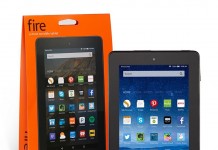
From an article in TechCrunch. It discusses data from Jumptab, a company that monitors web activity for advertising. More details therein:
But while Apple has seen a huge jump in smartphone users following the launch of the iPhone 4S last year, Jumptap’s figures indicate that in tablets it has a strong competitor in the form of the Kindle Fire, which now accounts for 33 percent of all tablet traffic on the network.
While these numbers do not exactly speak to how many Kindle Fire devices there are in use compared to iPads (we have a bit more on that subject here), it does point to the fact that people are using their Amazon devices for a whole lot of ad-based services.
…
In tablets, Amazon is proving to be a strong competitor, at least in the area of usage. In January, it accounted for 33 percent of all tablet traffic, and as you can see from the table below, that share has risen quickly over the last three months, outpacing even the growth of tablet traffic itself. Apple’s share, meanwhile, is at its lowest in four months, at 48 percent. Ditto the collective force of all of the other tablet makers.
This is a key point, because it indicates that those who are buying the Kindle Fire are also buying into the whole service-led proposition behind it …
(Via TechCrunch.)

































Stats can deceive. Notice that this data comes from a source that “monitors web activity for advertising.” This isn’t web use. This is advertising-related web use. Amazon Fire users are heavy into following ad links. That’s hardly surprising given that their Fire’s were purchased from Amazon, that Amazon attracts heavy consumers, and that the tablet is optimized for consumption. This data says little or nothing about total web usage much less tablet use in general.
Amazon’s also benefiting from the fact that Apple has shot itself in to foot by effectively banning non-Apple in-app purchasing with their 30% of retail fee. They’ve conceded consumer shopping on a tablet to others, including Amazon. The result is that it’s probably easier to buy an ebook on a Kindle Fire and have it sent to an iPad than it is to buy it on the iPad itself. In that area, Apple clearly doesn’t care about making the user experience as easy as possible.
So few companies have signed up and agreed to pay Apple’s ‘All Your Profits Are Ours’ fee that I can’t help but suspect that Apple, advised by their lawyers, has some convert agenda we’ll see revealed in the next couple of years. Their lawyers believe that by establishing this fee as a ‘mere’ company policy when it earns them almost nothing, they’d be able to avoid anti-trust action when they apply it in a field that’s enormously lucrative. And my guess it that field will be distribution of TV shows and movies via that sophisticated Apple television system that’s rumored to be in development.
In short, Apple forced Amazon to remove an in-app purchase link for ebooks not so much to improve modest iBookstore sales as to bolster its case when it attempts to establish a hardware & content lock-in for the far more lucrative entertainment market.
And it’s also conceding the entire ‘purchase via an app’ market to whoever is clever enough to create a heavily subsidized tablet having app-driven store shoppng from which the device-maker only accesses a 1 or 2% fee.
Michael is right.
TechCrunch:
“In tablets, Amazon is proving to be a strong competitor, at least in the area of usage.”
No. Amazon’s Fire is proving to be a strong magnet for users to “its U.S. mobile ad network “.
A wholly different thing to what the article is trying to present.